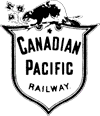










Canada Attorney General v. Canadian Pacific Ltd.
Canadian Pacific Railway Historical Association

The CPR's English Bay Branch, the intended terminus of the CPR, is a railroad book that discusses the question "Was the English Bay Branch the
intended terminus of the Canadian Pacific Railway?" The area that became downtown Vancouver reached that prominence because of a decision by the
CPR. They chose to end their main line along Burrard Inlet. But they seriously considered, and perhaps even intended, that the English Bay Branch
would be the final piece of their trans-continental railway to the Pacific Ocean. There are pictures and stories about the construction, operation,
and piecemeal demise of the English bay Branch. The book includes pictures of equipment, the right of way, maps of the area, and the facilities.
Second edition 1993. Published by Pacific Coast Branch of Canadian Railroad Historical Association in Vancouver.
In 1871, a tiny nation, just four years old, it's population well below the 4 million mark, determined that it would build the world's longest
railroad across empty country, much of it unexplored. This decision, bold to the point of recklessness, was to change the lives of every man, woman,
and child in Canada and alter the shape of the nation. Using primary sources, diaries, letters, unpublished manuscripts, public documents, and
newspapers, Pierre Berton has reconstructed the incredible decade of the 1870s, when Canadians of every stripe, contractors, politicians,
financiers, surveyors, workingmen, journalists, and entrepreneurs fought for the railway, or against it. The National Dream is above all else the
story of people. It is the story of George McMullen, the brash young promoter who tried to blackmail the Prime Minister, of Marcus Smith, the crusty
surveyor, so suspicious of authority he thought the Governor General was speculating in railway lands, of Sanford Fleming, the great engineer who
invented Standard Time but who couldn't make up his mind about the best route for the railway. All these figures, and dozens more, including the
political leaders of the era, come to life with all their human ambitions and failings.
In the four years between 1881 and 1885, Canada was forged into one nation by the building of the Canadian Pacific Railway. The Last Spike
reconstructs the incredible story of how some 2,000 miles of steel crossed the continent in just five years, exactly half the time stipulated in the
contract. Pierre Berton recreates the adventures that were part of this vast undertaking, the railway on the brink of bankruptcy, with one hour
between it and ruin, the extraordinary land boom of Winnipeg in 1881-1882, and the epic tale of how William Van Horne rushed 3,000 soldiers over a
half-finished railway to quell the Riel Rebellion. Dominating the whole saga are the men who made it all possible, a host of astonishing characters,
Van Horne, the powerhouse behind the vision of a transcontinental railroad, Rogers, the eccentric surveyor, Onderdonk, the cool New Yorker, Stephen,
the most emotional of businessmen, Father Lacombe, the black-robed voyageur, Sam Steele, of the North West Mounted Police, Gabriel Dumont, the
Prince of the Prairies, more than 7,000 Chinese workers, toiling and dying in the canyons of the Fraser Valley, and many more, land sharks,
construction geniuses, politicians, and entrepreneurs, all of whom played a role in the founding of Canada west of Ontario.

Land owners and land acquisition by the CPR.
Excerpt from Speeches on the Canadian Pacific Railway and the Canadian North West. Land owners and land acquisition by the
CPR.
How the city reporters of the 1950s must have loved Major Matthews. Eminently quotable, forthright, and provocative in speech, his mere presence
at any discussion of a contentious nature would be enough to ensure a wealth of good copy, and a strong, catchy headline as well. So writes Daphne
Sleigh in her compelling biography of controversial archivist Major James Skitt Matthews, whose dedication, dogged persistence, and guerrilla tactics
were instrumental in preserving the history of Vancouver. One of the city's great characters, Matthews was as noted for his fiery nature as he was for
his obsession with collecting artifacts and oral histories. In founding the City of Vancouver Archives, the prickly Major ensured that the history of
his beloved "magic city" would be available to future generations. By the time Matthews took up the heritage cause, he had already lived an
adventurous action-packed life. Sleigh's portrait of the Major covers his unique background and the unusual experiences that shaped the man and set
the stage for a remarkable future.

Speeches and description of locomotive 374 upon arrival at Vancouver pulling first transcontinental passenger train in 1887 and re-creation of this event in 1945. Major James Skitt Matthews was an archivist for the City of Vancouver. Held by Simon Fraser University call number FC 3847.4 M283 1968
Canadian Pacific Railway Bibliography .
.